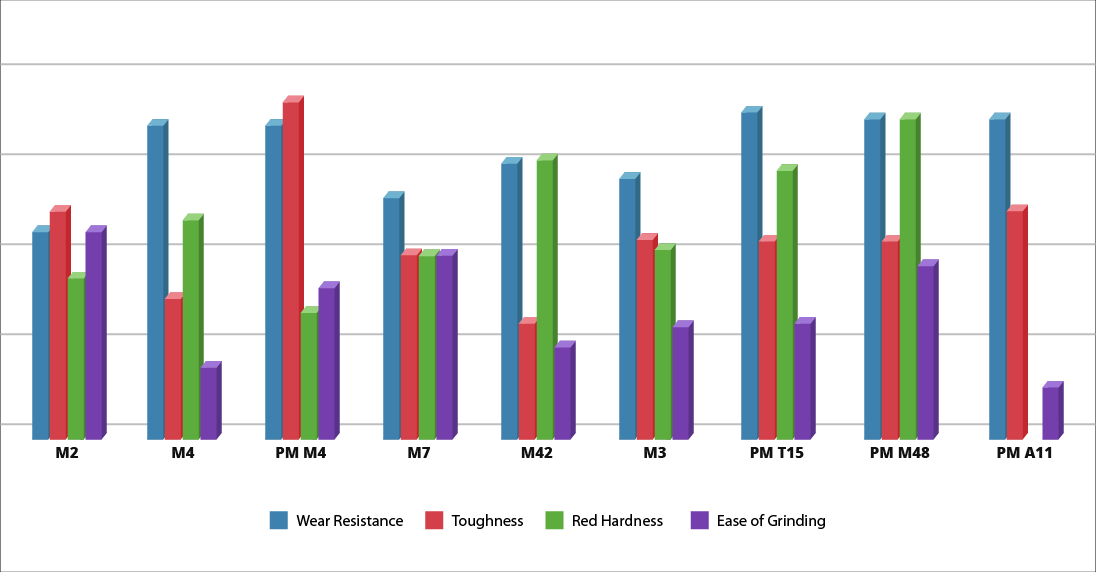For over 65 years, Griggs Steel Company has been known for providing the highest quality steel to the cutting tool and forming tool industries.
Our inventory of high-speed steels covers a variety of grades, including M42 cobalt steel.
Cobalt steel is a type of high-speed alloy steel used primarily for cutting tools. Introduced to manufacturers in 1900, high-speed steel, containing a mixture of tungsten, chromium, and trace amounts of carbon, enabled manufacturers to double or even triple their production.
High-speed cobalt steel, also known as HSCO, has a higher concentration of cobalt added to increase hardness and tolerance to heat. The amount of cobalt used determines the grade.
High-heat applications such as jet engines or gas turbines require cobalt steel, as it has high wear and corrosion resistance and will remain strong at temperatures over 1,200° F. The concentration of cobalt in these applications varies from 5-65%.
HSCO steel in concentrations of 2-12% is also used to cut other hard steels. Hard facing materials can contain up to 65% cobalt.
M42 cobalt steel is a molybdenum series, also known as M series, high-speed steel alloy. M series high-speed tool steels contain 7% molybdenum, tungsten and vanadium, and more than 0.6% carbon. More than 95% of all high-speed steels manufactured in the United States are M series steels.
M42 steel has another 8-10% cobalt added to the alloy for increased heat resistance, also called red hardness.
The common chemical composition of M42 cobalt steel is 1.1% carbon, 8.25% cobalt, 9.5% molybdenum 3.9% chromium, 1.2% vanadium and 1.6% tungsten. It has a heat-treated hardness, measured on the Rockwell scale, of 68 to 70 HRC. When used for cutting, it provides additional benefits like a lower initial cost, higher cutting speeds, lower cycle times and high production capacity.
M42 is a vital component for machining portable, space-age materials. It is used for machining pre-hardened high-strength steels, high-hardness alloys and nonferrous superalloys used in the aerospace, oil, and power generation industries.
Some common tools made of M42 steel include:
Griggs Steel Color Code:Red
Density
0.282 lb/in3 (7806 kg/m3)
Specific Gravity
7.81
Modulus Of Elasticity
30 x 106 psi (207 GPa)
Machinability
35-40% of a 1% carbon steel

| Maximum | Typical | ||||||
|---|---|---|---|---|---|---|---|
| Carbon | Chromium | Tungsten | Molybdenum | Vanadium | Cobalt | Annealed | Tempered |
| C | Cr | W | Mo | V | Co | Hb | HrC |
| 1.1 | 3.9 | 1.6 | 9.5 | 1.2 | 8.25 | 277 | 67 |
| Annealing | Preheat | Austenitizing | Quench | Tempering |
|---|---|---|---|---|
| Temp | Temp | Temp | Medium | Temp |
| °F | °F | °F | °F | |
| 1575/1650 | 1500/1550 | 2125/2175 | Salt/Oil/Atm | 1025/1050 |
Heat at a rate not exceeding 400°F per hour (222°C per hour) to 1500-1600°F (816-871°C, and equalize.
Heat rapidly from the preheat.
Furnace: 2150-2175°F (1177-1191°C)
Salt: 2125-2150°F (1163-1177°C)
To maximize toughness, use the lowest temperature. To maximize hot hardness, use the highest temperature.
Pressurized gas, warm oil, or salt. For pressurized gas, a rapid quench rate to below 1000°F (538°C) is critical to obtain the desired properties. For oil, quench until black, about 900°F (482°C), then cool in still air to 150-125°F (66-51°C). For salt maintained at 1000-1100°F (538-593°C), equalize, then cool in still air to 150-125°F (66-51°C).
Temper immediately after quenching. Typical tempering range is 1025-1050°F (551-565°C). Hold at temperature for 2 hours, then air cool to ambient temperature. Triple tempering is required.
Annealing must be performed after hot working and before re-hardening
Heat at a rate not exceeding 400°F per hour (222°C per hour) to 1575-1650°F (857-899°C), and hold at temperature for 1 hour per inch (25.4 mm) of thickness, 2 hours minimum. Then cool slowly with the furnace at a rate not exceeding 50°F per hour (28°C per hour) to 1000°F (538°C). Continue cooling to ambient temperature in the furnace or in air.